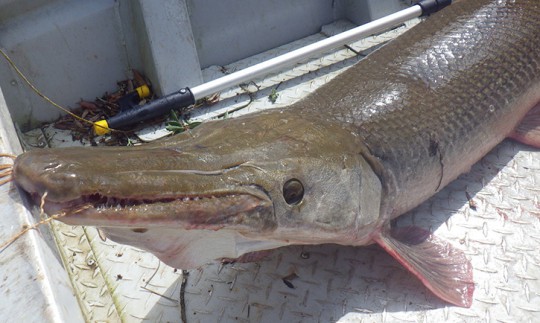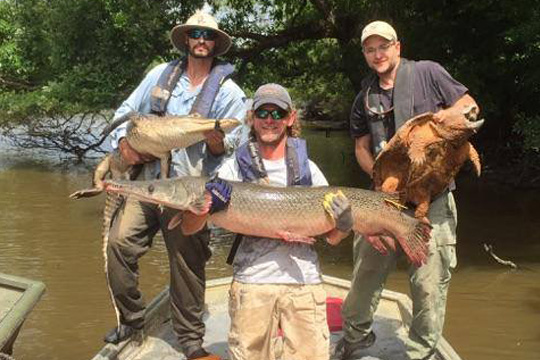Escambia River’s Gator Grand Slam
June 8, 2015
This Escambia River gator grand slam from the Florida Fish and Wildlife Conservation Commission Fish and Wildlife Research Institute is not for the faint of heart.
FWC freshwater fisheries researchers and herpetologists recently caught an alligator gar, alligator snapping turtle and an American alligator while conducting different studies at the same time on the Escambia River. American alligators are found in all 67 counties in Florida, but alligator gar and alligator snapping turtles are far less common.
Fnding alligator gar can be a challenge, but it’s one biologists with the Fish and Wildlife Research Institute are taking on to learn more about the population of the fish in Florida.
Alligator gar have historically resided in rivers and brackish waters throughout the southeastern U.S. from the Florida Panhandle – from the Apalachicola River west to the Perdido River – to Texas and Mexico. Since the mid-1900s, alligator gar numbers have declined, leaving populations in only half of the 14 states they once inhabited. The FWC acknowledged this in 2006, prohibiting harvest of alligator gar for all but scientific purposes.
 Since 2010, FWRI researchers have been tagging alligator gar in the Escambia River to learn more about their movement and habitat use. Using large-mesh gill nets, researchers collect adult alligator gar and fit them with telemetry tags before releasing them back into the river. These tags transmit information through radio and sound signals, allowing researchers to track each individual’s location for about two years.
Since 2010, FWRI researchers have been tagging alligator gar in the Escambia River to learn more about their movement and habitat use. Using large-mesh gill nets, researchers collect adult alligator gar and fit them with telemetry tags before releasing them back into the river. These tags transmit information through radio and sound signals, allowing researchers to track each individual’s location for about two years.
Three years into the study, researchers have tagged 22 alligator gar ranging from 11 pounds to a state record 132 pounds; tagged fish average 60 pounds. Researchers are trying to identify what habitats these fish prefer, how far they travel and whether they return to the same location over time. Preliminary tracking data indicate alligator gar are highly mobile and can travel more than 40 miles in a single week.
The data also reveal their movement and habitat use varies by season. In winter, the tagged fish tend to reside in a slough – a cove off the main river with no current – and move very little. As the season changes to spring, they begin traveling the river’s main channel but return repeatedly to the slough. Only in late spring did the gar venture from their home-base slough and begin cruising. Biologists recorded alligator gar moving as far north as Century and the Alabama state line and as far south as Escambia Bay during this time.
Courtesy photo for NorthEscambia.com, click to enlarge.
Comments
8 Responses to “Escambia River’s Gator Grand Slam”




Just remember when fishing in the river and if by chance one of these critters is caught on a line, just know if it is tagged it ain’t yours put it back.
Man, I think back on all the rivers & other places I went swimming in my youth, from here on down to Camp Euchee…
Don’t forget those ziplining incidents, keep it clean & get out of the water ifn ya get a cut or wound.
Looks like a lot of “inter-breeding” going between our river critters!
@ Jim…not just toes dangling in a tube ride.
We have invaded the habitat of nature’s dinosaurs…..beautiful in their ability to survive.
Haha – think about these critters when you’re drifting lazily down the blackwater with your toes dangling over the side of your tube. =o)
Oh wow! Im not going back in the rivers again.
Good Grief! Remind me to stay out of rivers around here!
Wouldnt want there jobs! That Turtle looks mean!